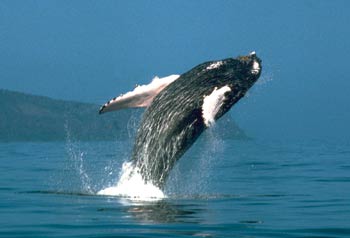Rope Burn
Eleventh Hour Unity Sought On Final Whale Rule
by Laurie Schreiber and Mike Crowe
|
As the National Marine Fisheries Service’s final whale management plan is written now, lobster fishermen who fish outside a proposed exemption zone have just one year, until Oct. 1, 2008, to change all of their floating ground lines to sinking or neutrally buoyant rope.
Given Maine’s rocky bottom, most fishermen will want a neutrally buoyant rope, which would hover above the ground and avoid costly snagging and chafing.
And yet, despite continual efforts of the state’s Department of Marine Resources, a successful version of this concept has not yet been developed.
“The fishermen feel there’s no way in hell the industry can comply with the October 2008 date,” said Maine Lobstermen’s Association executive director Patrice McCarron.
MLA’s board of directors met with the DMR Aug. 20, three days after the National Marine Fisheries Service published the Final Environmental Impact Statement designating Alternative 6 as the final preferred measures to amend the Atlantic Large Whale Take Reduction Plan. These measures will impact state and federal trap and gillnet fishermen from Maine to Florida.
continue
|

“We are going to lose a bunch of gear.” —Darrell Beal, Beals Island (upper left); “We’ve got to raise money to fight this thing.” —Dwight Carver, Newfield (lower left); “A full blown lawsuit against NMFS could amount to $500,000 or more.” —Patrice McCarron, MLA, (upper right); “Even $500,000 isn’t going to be enough, NMFS can chew it up.” —Cappy Sargent, Milbridge, (lower right) Laurie Schreiber photos, center photo NOAA |
|
|
|
|
Feds Indict MLA
May 1958
by Mike Crowe
|
The lobster fishery of Maine has been regulated by fishermen for many years. Within the system of managing the viability the fishery, established by fishermen over generations, are a means for determining who can fish and where. Settlement of territorial disputes is done among fishermen. Going to the police or government to settle a dispute is just not done. In addition to being, among other things, bad form, it just doesn’t work as well. By going to authorities rather than reaching a settlement among fishermen and everyone moving on, there is a residue of government left all over everything.
These disputes, often over territory, might involve the cutting of lines leaving someone’s traps on the bottom. Sometimes a lot of gear is lost on the bottom this way. These actions are generally considered lobster wars, every lobster fishermen knows of them and a few have firsthand experience.
But in the 1950s a different sort of lobster war erupted on the Maine coast. It was called the “great lobster war” in Ron Formisano’s comprehensive book of the same name. The issue was the low price paid fishermen for lobster, and the fact that the price was controlled by lobster dealers.
continue
|
| Left to right: John Knight, Rodney Cushing, Leslie Dyer, and Alan Grossman at the federal courthouse in Portland. The picture was probably taken during the price-fixing trial in 1958. Photo courtesy of Barry Faber. The Great Lobster War, Ron Formisano, courtesy University of Massachusetts Press, Amherst, Mass. |
|
|

